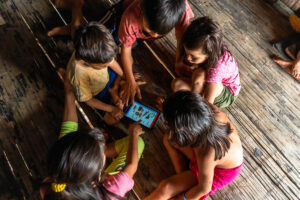
insert
In the latest update from our ongoing initiative with the Matsés to support bilingual education and intergeneration transfer of ecological knowledge, Dr. David Fleck reports on the development of three new interactive cell phone apps as well as the latest publication addition to Acate’s bilingual ecological readers collection in the Matsés language.
Governments are finally acknowledging the importance of indigenous territories and promoting indigenous land ownership rather than national parks as the most effective conservation strategy. This shift is certainly a step in the right direction but stand-alone it is not a well-developed conservation strategy as it ignores the rapid cultural changes occurring in remote areas. It is the cultural practices and worldview of these groups that drive their protection of their territories so this strategy can only be effective if the people chose to maintain their cultures. It is within this context that Acaté has been working since 2012 to ensure the continued intergenerational transmission of cultural knowledge and especially ethnoecological knowledge among the Matsés. One of the drivers of cultural degradation is when young people become ashamed of their culture and feel it is backward compared to the technological marvels of the global culture. To engage young Matsés, Acaté has created three new educational mobile phone apps (downloadable here from Google Play store). Beyond the value of the apps as practical learning tools, they also demonstrate to the Matsés that they can both enjoy modern technology and maintain their culture.
The Covid-19 pandemic and resulting response in Peru has had devastating effect on the quality of education across the country. This is particularly true in Matsés territory, where internet service and cellular telephone service is absent. Even prior to the COVID-19 pandemic, the Matsés education system struggled profoundly with chronic lack of teachers, educational materials and resources. The few available educational materials are poorly written. Last year, the Peruvian Ministry of Education has distributed tablets to students in some of Matsés villages, but without any content in the Matsés language which is their primary language. To provide educational resources, Acaté Amazon Conservation, in collaboration with Matsés elders, has produced four new cellular phone apps (download here from the Google Play store) that Matsés children can use to learn at home as well as another ecology advanced reader. In September 2021, Acate field coordinator, Felipe Ëpë Bai Unan traveled to all the Matsés villages, installing the apps on the cell phones and tablets of the Matsés who have them and distributing the ecology reader to the children.
Aprende a Leer Matsés
This cellular application was an instant hit among the Matsés children. It is a fun interactive application with incorporated audio clips that teaches Matsés children to read at the word level in their language. The app features 200 illustrations drawn by Matses artist Guillermo Nëcca Pëmen Mënquë. In the first half of this talking reader, each letter of the Matsés alphabet is introduced with 5 or 6 simple words.
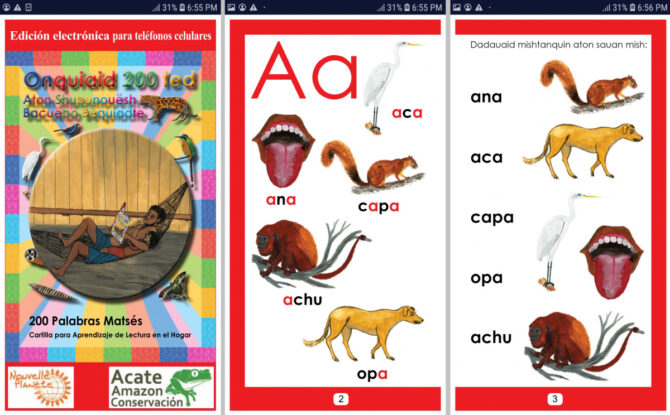
In the second half of the app, the different syllable types are introduced.

On the even pages, the introduced words are associated with images that can be tapped to hear the pronunciation of the word, and on the odd pages the children play a matching game with the same words and illustrations introduced in the preceding page (a correct match elicits an approval tune and the word and image disappear from the page). The matching game can be used by a single child as a self-evaluation exercise, or two or more children can play competitively taking turns to see who gets more correct matches.
Animales Matsés
This app features drawings of 504 species of animals present in Matsés territory by Matsés artist Guillermo Nëcca, along with names of the animals in the Matsés language and in local Spanish, accompanied by sound clips of the Matsés names that play when an image is tapped.
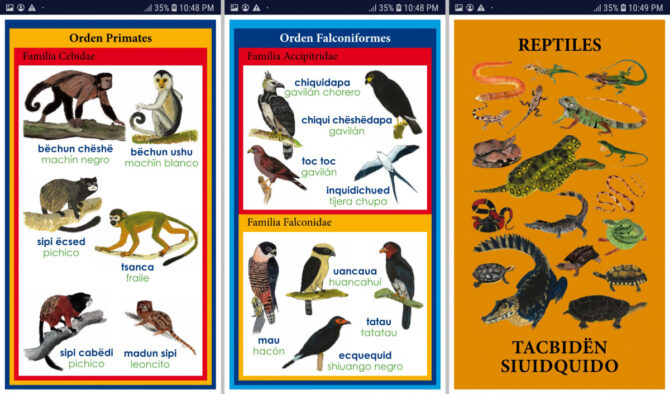
Older Matsés men and women know the names of all the animals, but many young Matsés know only the more common species, so one of the principle aims of this app is to encourage the intergenerational transmission of traditional ecological knowledge. Non-readers can use the app to learn the animal names by tapping the images, emergent readers can learn to learn to read at the word level in Matsés, and older Matsés students can use it to learn the local Spanish names and to become familiar with scientific classification. At all levels younger Matsés will become familiar with the traditional nomenclature of all the types of animals in their territory.
Taxonomía de Plantas Matsés
This app is in effect the botanical counterpart of the Animales Matsés app. It is the first of its kind. The 122-page application illustrates the amazingly high plant diversity found Western Amazonia along with the sophisticated traditional plant knowledge of the Matsés people with drawings of 361 species of plants drawn by Matsés artist Guillermo Nëcca Pëmen Mënquë.

It is the product of more than a year or research trekking through the forests with Matsés elders, searching for and photographing trees and plants with fruits or flowers (without which it is difficult to identify Amazonian plants).

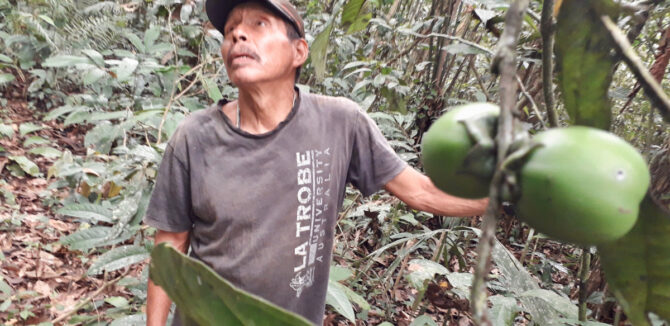
Matsés elder Luis Dunu Jiménez Duni while searching for trees and plant with fruits or flowers to photograph.©Acaté
Matsés children and young adults often accompanied us on these long treks, which gave the elders a chance to teach the children about plants important to the Matsés and the forest.©Acaté

Dr. Fleck has 20 years of zoological, ethnographic and linguistic fieldwork among the Matsés. He has written over 30 scientific publications on the Matsés culture, language, and ethnobiology.©Acaté
We will also be seeking funding to produce even more educational applications for the Matsés, including math games, games for teaching Spanish and English, and talking ecological readers.
If you have an Android cell phone or tablet, we encourage you to download and check out the apps here. If you do not have access to an Android device, you can download pdfs below:
Aprende a leer Matsés
Animales Matsés
Taxonomía de plantas Matsés
Ecología Completa de los Reptiles (Complete Natural History of Reptiles)
This 77-page printed book (also available as a pdf) is the third volume in Acate’s collection of advanced level ecological readers, which are designed to facilitate the intergenerational transfer of traditional ecological knowledge and assist Matsés students in learning to read.
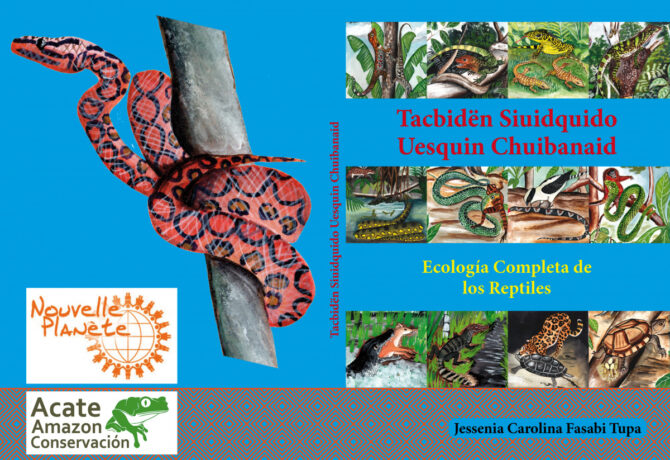
The book was written by Matsés author Jessenia Carolina Fasabi Tupa based on recorded monologues about reptile natural history provided by Matsés elders Joaquin Tëca Rojas and Luis Dunu Jiménez Dësi. Scenes depicting behaviors of 54 folk species of reptiles are illustrated with 70 watercolor drawings by Matsés artist Guillermo Nëcca Pëmen Mënquë.
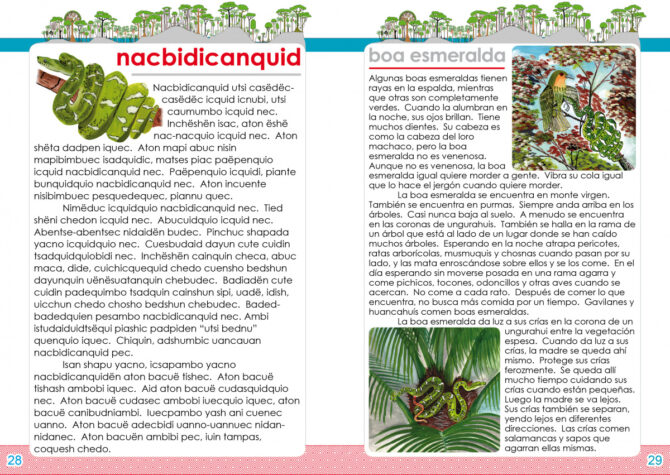
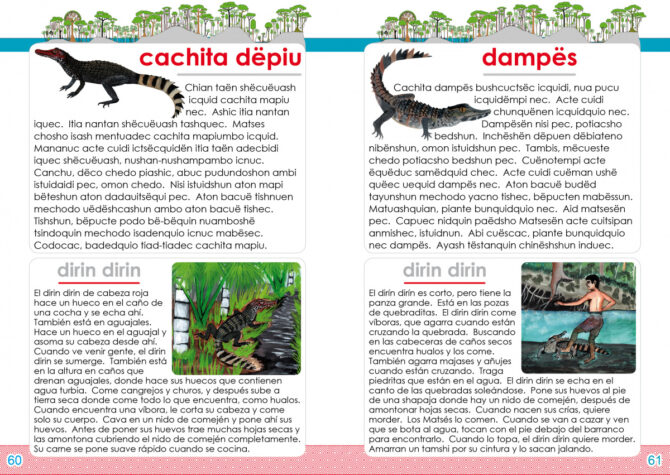
The advanced reptile ecology reader was distributed in September 2021 to all the Matsés communities in Peru.

Counting the 7 elementary level ecological readers published by Acate in 2018, the Matsés now have 10 published bilingual ecological readers for helping children learn their ancestral ecological knowledge and to learn to read in their language and in Spanish. This body of work has effectively doubled the number of educational books in the Matsés language. The next book in the advance ecology reader series will be one on amphibians, and later ones on fish, invertebrates, monocot plants, and dicot plants.
We would like to express our gratitude to Nouvelle Planète who generously financed this project.
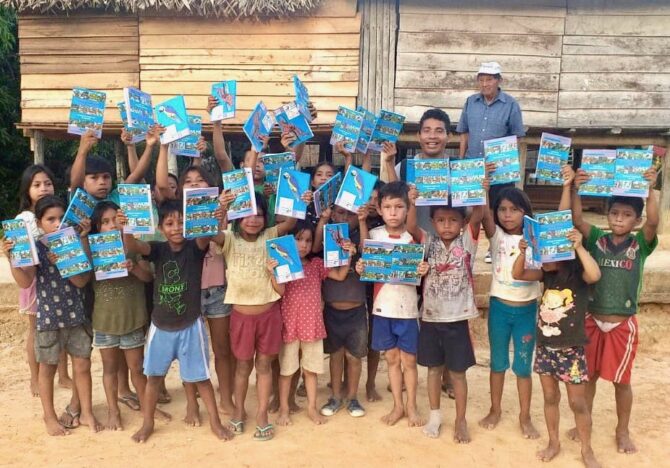
If you missed it, take a look at our July 2021 Field Report on major advances in the Matsés critical initiative for indigenous empowerment and governance! As a result of this initative, the Matsés have translated their community bylaws into the Matsés language, explained key Peruvian government regulations to all their leaders and communities. The initiative has resulted in training of over 140 Matsés in computer literacy as well as the set-up and equipping of the first computer lab in Matsés territory. The Matsés developed a written Plan of Life (Plan de Vida) to guide their implementation of their vision and aspirations for their communities and protection of their ancestral territories for years to come. The Matsés applied and received United Nations recognition of the Matsés Ancestral Territory as an indigenous and community conserved area (ICCA), the first such designation for an indigenous community in Peru.
All content and images copyright 2022 Acaté
